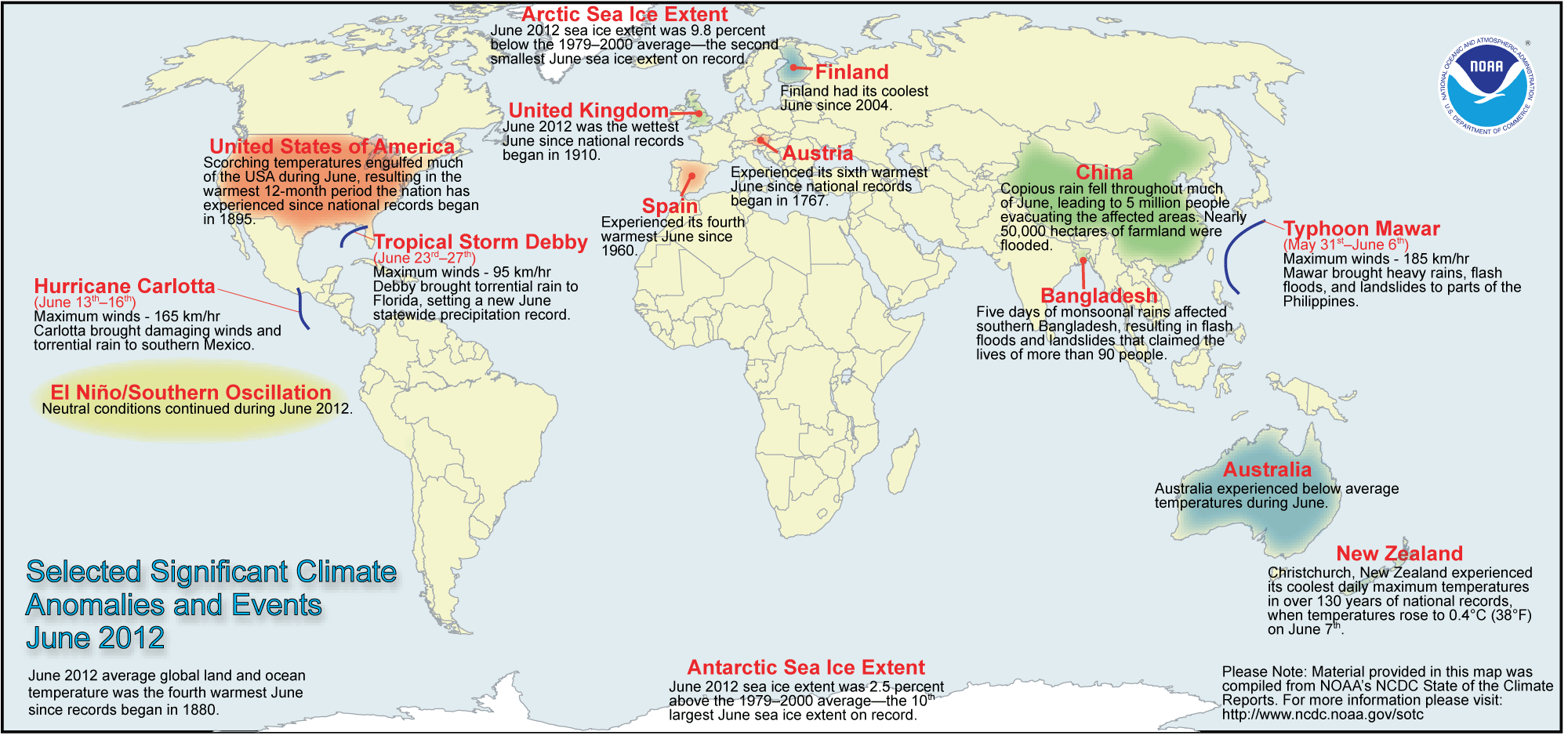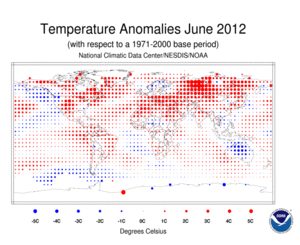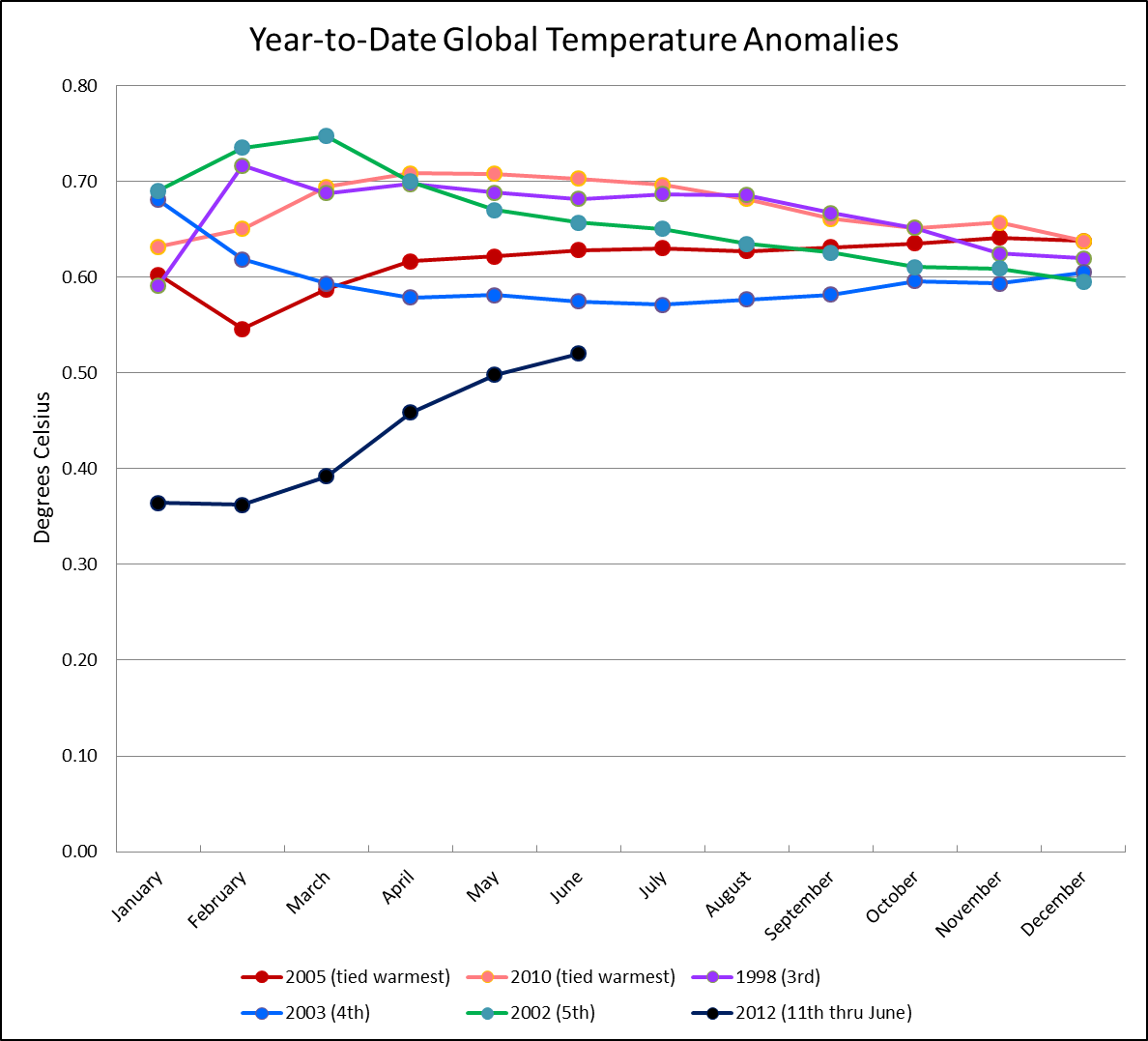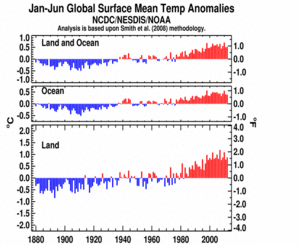Dá para usar o tradutor, em suma: as temperaturas estão anômalas, e subindo.
Abraço geral, Gustavo Cherubine.
http://www.ncdc.noaa.gov/sotc/global/2012/6


- Climate Monitoring
- State of the Climate
- Global Analysis
- Help
State of the Climate
Global Analysis
June 2012
National Oceanic and Atmospheric Administration
National Climatic Data Center
Use the form below to access monthly reports.
Note: The data presented in this report are preliminary. Ranks and anomalies may change as more complete data are received and processed. Effective November 2011, the GHCN-M version 3.1.0 dataset of monthly mean temperature replaced the GHCN-M version 3 monthly mean temperature dataset. Beginning with the October 2011 Global monthly State of the Climate Report, GHCN-M version 3.1.0 is used for NCDC climate monitoring activities, including calculation of global land surface temperature anomalies and trends.
For more information about this newest version, please see the Modifications to Pairwise Homogeneity Adjustment software to address coding errors and improve run-time efficiency.
Contents of this Section:
 June 2012 Selected Climate
June 2012 Selected Climate
Anomalies and Events Map
Global Highlights
- The average combined global land and ocean surface temperature for June 2012 was 0.63°C (1.13°F) above the 20th century average of 15.5°C (59.9°F). This is the fourth warmest June since records began in 1880.
- The Northern Hemisphere land and ocean average surface temperature for June 2012 was the all-time warmest June on record, at 1.30°C (2.34°F) above average.
- The globally-averaged land surface temperature for June 2012 was also the all-time warmest June on record, at 1.07°C (1.93°F) above average.
- ENSO-neutral conditions continued in the eastern equatorial Pacific Ocean during June 2012 as sea surface temperature anomalies continued to rise. The June worldwide ocean surface temperatures ranked as the 10th warmest June on record.
- The combined global land and ocean average surface temperature for January–June 2012 was the 11th warmest on record, at 0.52°C (0.94°F) above the 20th century average.
Please Note: The data presented in this report are preliminary. Ranks and anomalies may change as more complete data are received and processed. Effective with the July 2010 State of the Climate Report, NCDC transitioned to the new version (version 3b) of the extended reconstructed sea surface temperature (ERSST) dataset. ERSST.v3b is an improved extended SST reconstruction over version 2. For more information about the differences between ERSST.v3b and ERSST.v2 and to access the most current data, please visit NCDC’s Global Surface Temperature Anomalies page.
Introduction
Temperature anomalies for June 2012 are shown on the dot maps below. The dot maps on the left provide a spatial representation of anomalies calculated from the Global Historical Climatology Network (GHCN) dataset of land surface stations using a 1961–1990 base period. The dot maps on the right are a product of a merged land surface and sea surface temperature (SST) anomaly analysis developed by Smith et al. (2008). For the merged land surface and SST analysis, temperature anomalies with respect to the 1971–2000 average for land and ocean are analyzed separately and then merged to form the global analysis. For more information, please visit NCDC’s Global Surface Temperature Anomalies page.
Temperatures
In the atmosphere, 500-millibar height pressure anomalies correlate well with temperatures at the Earth’s surface. The average position of the upper-level ridges of high pressure and troughs of low pressure—depicted by positive and negative 500-millibar height anomalies on the June 2012 map—is generally reflected by areas of positive and negative temperature anomalies at the surface, respectively.
June
The average global temperature across land and oceans during June 2012 was 0.63°C (1.13°F) above the 20th century average of 15.5°C (59.9°F) and ranked as the fourth warmest June since records began in 1880. June 2012 also marks the 36th consecutive June and 328thconsecutive month with a global temperature above the 20th century average. The last below-average June temperature was June 1976 and the last below-average temperature for any month was February 1985. It was the second warmest June in the Northern Hemisphere, behind only the record warmth of 2010. The Southern Hemisphere had its 12th warmest June on record.
The global land surface temperature for June was 1.07°C (1.93°F) above the 20th century average of 13.3°C (55.9°F), the warmest June on record. This is the second month in a row that the global land temperature was the warmest on record for that month.
The Northern Hemisphere average land temperature, where the majority of Earth’s land is located, was record warmest for June. This makes three months in a row — April, May, and June — in which record-high monthly land temperature records were set. Most areas experienced much higher-than-average monthly temperatures, including most of North America and Eurasia, and northern Africa. Only northern and western Europe, and the northwestern United States were notably cooler than average.
- Austria recorded its highest ever June temperature of 37.7°C (99.9°F) on June 30th in two locations — the capital city of Vienna and in German-Altenburg, Nope. This bests the previous record of 37.2°C (98.9°F) set on June 22nd, 2000 in both Lutmannburg, Burganland and Langenlebarn, Nope. The monthly temperature averaged across Austria was the sixth warmest June since national records began 250 years ago.
- Norway experienced its 25th coolest June since records began in 1900, at 1.2°C (2.2°F) below average. Parts of eastern Norway observed temperatures that were 2–3°C (3.6–4.5°F) below their local monthly averages.
- The monthly temperature during June in the United Kingdom was 0.3°C (0.5°F) below the 1971–2000 average, making this the coolest June since 1991.
The Southern Hemisphere land temperature was the 20th warmest on record.
- Australia remained cooler than average during June. The average daytime (maximum) temperature was 0.27°C (0.49°F) below the 1961–1990 average, while the nighttime (minimum) temperature had a greater departure, 0.94°C (1.69°F) below average.
Across the world’s oceans, the June average global sea surface temperature was 0.47°C (0.85°F) above the 20th century average of 16.4°C (61.5°F), the 10th warmest June on record. Ocean temperatures were notably below average in the northeastern Pacific Ocean and much higher than average in the northeast Atlantic and in the Labrador Sea near Greenland. The region of the equatorial Pacific Ocean where ENSO conditions are measured also trended higher than average in June. NOAA’s Climate Prediction Center issued an El Niño watch, and stated that there is an increased chance for El Niño beginning in July–September 2012.
| June | Anomaly | Rank (out of 133 years) |
Records | |||
|---|---|---|---|---|---|---|
| °C | °F | Year(s) | °C | °F | ||
| Global | ||||||
| Land | +1.07 ± 0.13 | +1.93 ± 0.23 | 1st Warmest | Warmest: 2012 | +1.07 | +1.93 |
| 133rd Coolest | Coolest: 1907 | -0.60 | -1.08 | |||
| Ocean | +0.47 ± 0.04 | +0.85 ± 0.07 | 10th Warmest | Warmest: 1998 | +0.59 | +1.06 |
| 124th Coolest | Coolest: 1909, 1911 | -0.50 | -0.90 | |||
| Ties: 2011 | ||||||
| Land and Ocean | +0.63 ± 0.07 | +1.13 ± 0.13 | 4th Warmest | Warmest: 2010 | +0.67 | +1.21 |
| 130th Coolest | Coolest: 1911 | -0.44 | -0.79 | |||
| Northern Hemisphere | ||||||
| Land | +1.30 ± 0.14 | +2.34 ± 0.25 | 1st Warmest | Warmest: 2012 | +1.30 | +2.34 |
| 133rd Coolest | Coolest: 1907 | -0.66 | -1.19 | |||
| Ocean | +0.46 ± 0.04 | +0.83 ± 0.07 | 11th Warmest | Warmest: 2009 | +0.62 | +1.12 |
| 123rd Coolest | Coolest: 1910 | -0.53 | -0.95 | |||
| Ties: 2001, 2011 | ||||||
| Land and Ocean | +0.78 ± 0.10 | +1.40 ± 0.18 | 2nd Warmest | Warmest: 2010 | +0.80 | +1.44 |
| 132nd Coolest | Coolest: 1913 | -0.47 | -0.85 | |||
| Southern Hemisphere | ||||||
| Land | +0.47 ± 0.11 | +0.85 ± 0.20 | 20th Warmest | Warmest: 2005 | +1.05 | +1.89 |
| 114th Coolest | Coolest: 1893 | -1.00 | -1.80 | |||
| Ocean | +0.48 ± 0.04 | +0.86 ± 0.07 | 10th Warmest | Warmest: 1998 | +0.60 | +1.08 |
| 124th Coolest | Coolest: 1911 | -0.55 | -0.99 | |||
| Ties: 2011 | ||||||
| Land and Ocean | +0.48 ± 0.06 | +0.86 ± 0.11 | 12th Warmest | Warmest: 1998 | +0.63 | +1.13 |
| 122nd Coolest | Coolest: 1911 | -0.61 | -1.10 | |||
Year-to-date (January–June)
Following the dissipation of La Niña in April, record warmth over land during May and June and increasing ocean temperature anomalies pushed 2012 near the top 10 warmest status for the first half of the year. The combined global land and ocean average surface temperature for the January–June period was 0.52°C (0.94°F) above the 20th century average of 13.5°C (56.3°F), ranking as the 11th warmest such period on record. The greatest January–June warmth was observed over most of North America, southern Greenland, and most of Russia. The first half of 2012 was notably cooler than average across Alaska, Mongolia, and Australia.
- Alaska had its 16th coolest January–June since records began in 1918, with a temperature 1.5°C (2.7°F) below the 1971–2000 average.
Of note, the year-to-date global anomalies for 2012 have increased each month as the year has progressed and La Niña conditions waned — January: +0.35°C (+0.65°F); January–February: +0.37°C (+0.67°F); January–March: +0.39°C (+0.70°F); January–April: +0.46°C (+0.83°F); January–May: +0.50°C (+0.90°F), and January–June: +0.52°C (+0.94°F). The record for the warmest January–June was set in 2010, with a temperature that was 0.70°C (1.26°F) above average.
The January–June worldwide land surface temperature was 0.87°C (1.57°F ) above the 20thcentury average, marking the sixth warmest such period on record.
The global ocean surface temperature for the year to date was 0.39°C (0.70°F) above average and ranked as the 12th warmest such period on record. This was the warmest monthly departure from average since August 2010.
| January–June | Anomaly | Rank (out of 133 years) |
Records | |||
|---|---|---|---|---|---|---|
| °C | °F | Year(s) | °C | °F | ||
| Global | ||||||
| Land | +0.88 ± 0.21 | +1.58 ± 0.38 | 6th Warmest | Warmest: 2007 | +1.19 | +2.14 |
| 128th Coolest | Coolest: 1893 | -0.85 | -1.53 | |||
| Ocean | +0.39 ± 0.04 | +0.70 ± 0.07 | 12th Warmest | Warmest: 1998 | +0.57 | +1.03 |
| 122nd Coolest | Coolest: 1911 | -0.51 | -0.92 | |||
| Land and Ocean | +0.52 ± 0.09 | +0.94 ± 0.16 | 11th Warmest | Warmest: 2010 | +0.70 | +1.26 |
| 123rd Coolest | Coolest: 1911 | -0.50 | -0.90 | |||
| Northern Hemisphere | ||||||
| Land | +1.04 ± 0.26 | +1.87 ± 0.47 | 5th Warmest | Warmest: 2007 | +1.38 | +2.48 |
| 129th Coolest | Coolest: 1893 | -0.96 | -1.73 | |||
| Ocean | +0.38 ± 0.05 | +0.68 ± 0.09 | 9th Warmest | Warmest: 2010 | +0.56 | +1.01 |
| 125th Coolest | Coolest: 1910 | -0.48 | -0.86 | |||
| Ties: 2006 | ||||||
| Land and Ocean | +0.63 ± 0.14 | +1.13 ± 0.25 | 7th Warmest | Warmest: 2007 | +0.81 | +1.46 |
| 127th Coolest | Coolest: 1893 | -0.59 | -1.06 | |||
| Southern Hemisphere | ||||||
| Land | +0.46 ± 0.16 | +0.83 ± 0.29 | 17th Warmest | Warmest: 2005 | +0.95 | +1.71 |
| 117th Coolest | Coolest: 1917 | -0.85 | -1.53 | |||
| Ties: 1993, 2001 | ||||||
| Ocean | +0.41 ± 0.04 | +0.74 ± 0.07 | 13th Warmest | Warmest: 1998 | +0.60 | +1.08 |
| 121st Coolest | Coolest: 1911 | -0.53 | -0.95 | |||
| Ties: 1999 | ||||||
| Land and Ocean | +0.42 ± 0.07 | +0.76 ± 0.13 | 13th Warmest | Warmest: 1998 | +0.65 | +1.17 |
| 121st Coolest | Coolest: 1911 | -0.55 | -0.99 | |||
| Ties: 1988, 1992, 1999 | ||||||
The most current data June be accessed via the Global Surface Temperature Anomalies page.
Images of sea surface temperature conditions are available for all weeks during 2012 from the weekly SST page.
Precipitation
The maps below represent anomaly values based on the GHCN dataset of land surface stations using a base period of 1961–1990. As is typical, precipitation anomalies during June 2012 varied significantly around the world.
- Low pressure systems brought the United Kingdom its wettest June since national records began in 1910. England and Wales each tied with 1860 as the wettest June since their records began in 1766.
- The Southwest Asian monsoon made its way northward across India during June. As of June 27th, the country as whole reported monthly rainfall that was 77 percent of the average amount received. Regionally, northwest India was just 37 percent of average, while east and northeast India was wetter than usual, at 104 percent of average. By the last week in June, the monsoon had reached central India.
Additional details on flooding and drought events around the world can also be found on theJune 2012 Global Hazards page.
References
Peterson, T.C. and R.S. Vose, 1997: An Overview of the Global Historical Climatology Network Database. Bull. Amer. Meteorol. Soc., 78, 2837-2849.
Quayle, R.G., T.C. Peterson, A.N. Basist, and C. S. Godfrey, 1999: An operational near-real-time global temperature index. Geophys. Res. Lett., 26, 333-335.
Smith, T.M., and R.W. Reynolds (2005), A global merged land air and sea surface temperature reconstruction based on historical observations (1880-1997), J. Clim., 18, 2021-2036.
Smith, et al (2008), Improvements to NOAA’s Historical Merged Land-Ocean Surface Temperature Analysis (1880-2006), J. Climate., 21, 2283-2293.
Citing This Report
NOAA National Climatic Data Center, State of the Climate: Global Analysis for June 2012, published online July 2012, retrieved on July 16, 2012 fromhttp://www.ncdc.noaa.gov/sotc/global/2012/6.Questions?
For questions on technical or scientific content of this report, please contact:
CMB Contact:[email protected]
For general climate monitoring questions, please contact:
[email protected]For climate data orders, please contact the National Climatic Data Center’s Climate Services and Monitoring Division:
[email protected]- Climate Monitoring
- State of the Climate
- Global Analysis
- Help
![]()
Downloaded Monday, 16-Jul-2012 12:35:12 EDT
Last Updated Monday, 16-Jul-2012 11:02:59 EDT by [email protected]
Please see the NCDC Contact Page if you have questions or comments.
Você pode fazer o Jornal GGN ser cada vez melhor.
Apoie e faça parte desta caminhada para que ele se torne um veículo cada vez mais respeitado e forte.



 produtos
produtos
















